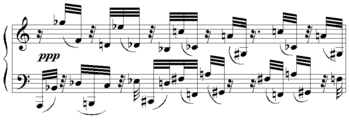
Drei Klavierstücke
Encyclopedia

Arnold Schoenberg
Arnold Schoenberg was an Austrian composer, associated with the expressionist movement in German poetry and art, and leader of the Second Viennese School...
in 1909. They represent an early example of ‘atonality
Atonality
Atonality in its broadest sense describes music that lacks a tonal center, or key. Atonality in this sense usually describes compositions written from about 1908 to the present day where a hierarchy of pitches focusing on a single, central tone is not used, and the notes of the chromatic scale...
’ in the composer’s work. The tempo markings of the three pieces are:
- Mässig (at a moderate speed)
- Mässig (at a moderate speed)
- Bewegt (with motion)
The Three Piano Pieces form an important milestone in the evolution of Schoenberg’s compositional style. The first two, dating from February 1909, are often cited as marking the point at which Schoenberg abandoned the last vestiges of traditional ‘tonality
Tonality
Tonality is a system of music in which specific hierarchical pitch relationships are based on a key "center", or tonic. The term tonalité originated with Alexandre-Étienne Choron and was borrowed by François-Joseph Fétis in 1840...
’, implying the language of common practice harmony that had been inherent in western music in one way or another for centuries. The functionality of this language, to Schoenberg at least, had by this time become stretched to bursting point in some of the more chromatically saturated works of Wagner
Richard Wagner
Wilhelm Richard Wagner was a German composer, conductor, theatre director, philosopher, music theorist, poet, essayist and writer primarily known for his operas...
, Mahler
Gustav Mahler
Gustav Mahler was a late-Romantic Austrian composer and one of the leading conductors of his generation. He was born in the village of Kalischt, Bohemia, in what was then Austria-Hungary, now Kaliště in the Czech Republic...
, Richard Strauss
Richard Strauss
Richard Georg Strauss was a leading German composer of the late Romantic and early modern eras. He is known for his operas, which include Der Rosenkavalier and Salome; his Lieder, especially his Four Last Songs; and his tone poems and orchestral works, such as Death and Transfiguration, Till...
and indeed some of Schoenberg's own earlier tonal works such as the string sextet Verklärte Nacht
Verklärte Nacht
Verklärte Nacht , Op. 4, is a string sextet in one movement composed by Arnold Schoenberg in 1899 and his earliest important work...
, Op. 4 of 1899.
This use of the term ‘expression’ is especially pertinent when applied to the third of the Three Pieces, written in August 1909, whose violent emotional language, juxtaposing extremes of mood and dynamic, can be seen in the context of Schoenberg’s other ‘expressionist’ works of that year such as the last of the Five Orchestral Pieces, Op. 16 and, most revealingly, the monodrama Erwartung
Erwartung
Erwartung , Op.17 is a one-act opera by Arnold Schoenberg to a libretto by Marie Pappenheim. Composed in 1909, it was not premiered until June 6, 1924 in Prague conducted by Alexander Zemlinsky with Marie Gutheil-Schoder as the soprano. The work takes the unusual form of a monologue for solo...
. Characteristic of these pieces is a lack of motivic repetition or development and a rejection of traditional notions of balance and cadential, goal-oriented movement, supposedly deferring the musical discourse to a kind of stream of consciousness or subjective emotional expression. Probably because of this radical abandonment of traditional parameters, Busoni found the third piece rather harder to digest than the first two, and indeed its language does set it apart from its companions somewhat. In likening these developments to contemporary styles in visual art (Schoenberg was himself a painter), notably Kandinsky’s, with whom he had contact, the composer tellingly describes painting “without architecture … an ever-changing, unbroken succession of colours, rhythms and moods.”
The violence and suddenness of this emancipation from tradition was influenced by turbulent events in Schoenberg’s life at the time: his wife Mathilde had recently eloped with the painter Richard Gerstl
Richard Gerstl
Richard Gerstl was an Austrian painter and draughtsman known for his expressive psychologically insightful portraits, his lack of critical acclaim during his lifetime, and his affair with the wife of Arnold Schoenberg which led to his suicide.Richard Gerstl was born in a prosperous civil family,...
(who committed suicide when Mathilde returned to her husband), and in the professional sphere, his work was increasingly being met with hostility or incomprehension, as at the premiere of the Second String Quartet in 1908. However, Schoenberg at this time saw no contradiction in pursuing more seemingly 'traditional' projects, such as the orchestration of his hyper-Wagnerian Gurrelieder (completed in 1911), bearing out his contention that the new style was, for him, an extension of previous practice, not a rejection of it.

